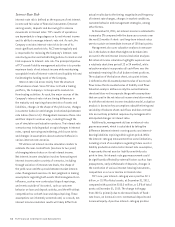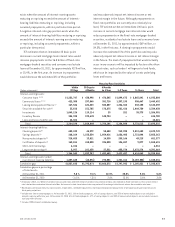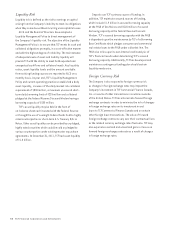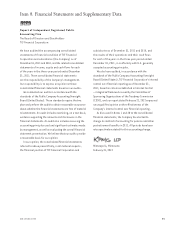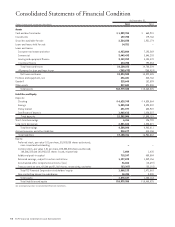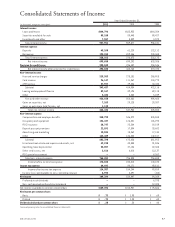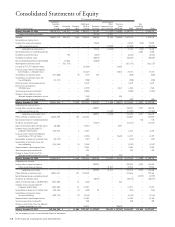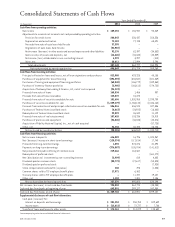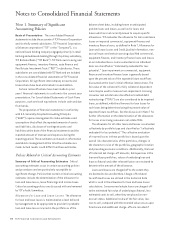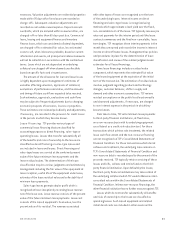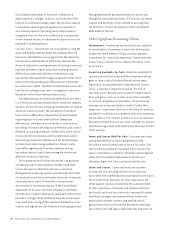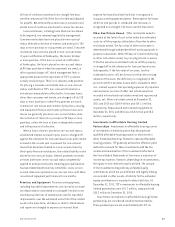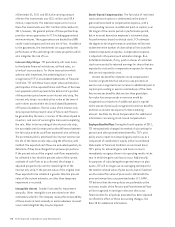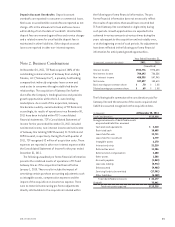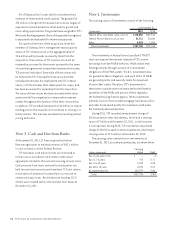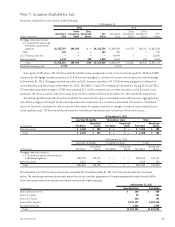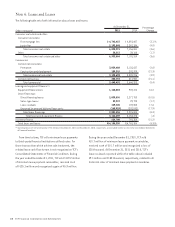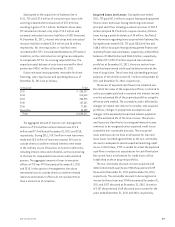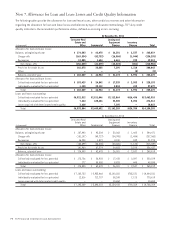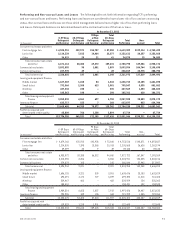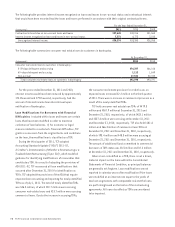TCF Bank 2011 Annual Report Download - page 80
Download and view the complete annual report
Please find page 80 of the 2011 TCF Bank annual report below. You can navigate through the pages in the report by either clicking on the pages listed below, or by using the keyword search tool below to find specific information within the annual report.Consolidated Statements of Financial Condition and
depreciated on a straight-line basis over the term of the
lease to its estimated salvage value. Depreciation expense
is recorded as operating lease expense and included in
non-interest expense. Operating lease rental income is
recognized when it is due and is reflected as a component
of non-interest income. An allowance for lease losses is not
provided on operating leases.
Income Taxes Income taxes are accounted for using the
asset and liability method. Under this method, deferred
tax assets and liabilities are recognized for the future tax
consequences attributable to differences between the
financial statement carrying amounts of existing assets and
liabilities and their respective tax-basis carrying amounts.
Deferred tax assets and liabilities are measured using
enacted tax rates expected to apply to taxable income in the
years in which those temporary differences are expected to
be recovered or settled. The effect on deferred tax assets and
liabilities of a change in tax rates is recognized in income in
the period in which the enactment date occurs.
The determination of current and deferred income taxes
is a critical accounting estimate which is based on complex
analyses of many factors including interpretation of federal
and state income tax laws, the evaluation of uncertain
tax positions, differences between the tax and financial
reporting bases of assets and liabilities (temporary
differences), estimates of amounts due or owed such as
the timing of reversal of temporary differences and current
financial accounting standards. Additionally, there can be
no assurance that estimates and interpretations used in
determining income tax liabilities will not be challenged
by federal and state taxing authorities. Actual results
could differ significantly from the estimates and tax
law interpretations used in determining the current and
deferred income tax liabilities.
In the preparation of income tax returns, tax positions
are taken based on interpretation of federal and state
income tax laws for which the outcome is uncertain.
Management periodically reviews and evaluates the status
of uncertain tax positions and makes estimates of amounts
ultimately due or owed. The benefits of tax positions
are recorded in income tax expense in the Consolidated
Statements of Income, net of the estimates of ultimate
amounts due or owed including any applicable interest and
penalties. Changes in the estimated amounts due or owed
may result from closing of the statute of limitations on tax
returns, new legislation, clarification of existing legislation
through government pronouncements, the courts and
through the examination process. TCF’s policy is to report
interest and penalties, if any, related to unrecognized
tax benefits in income tax expense in the Consolidated
Statements of Income.
Other Significant Accounting Policies
Investments Investments are carried at cost, adjusted
for amortization of premiums or accretion of discounts,
using a level yield method. TCF periodically evaluates
investments for “other than temporary” impairment with
losses, if any, recorded in non-interest income as a loss
on securities.
Securities Available for Sale Securities available for
sale are carried at fair value with the unrealized holding
gains or losses, net of related deferred income taxes,
reported as accumulated other comprehensive income
(loss), a separate component of equity. The cost of
securities sold is determined on a specific identification
basis and gains or losses on sales of securities available
for sale are recognized on trade dates. TCF periodically
evaluates securities available for sale for “other than
temporary” impairment. Declines in the value of securities
available for sale that are considered other than temporary
are recorded in non-interest income as a loss on securities.
Discounts and premiums on securities available for sale are
amortized using a level yield method over the expected life
of the security.
Loans and Leases Held for Sale Consumer auto loans
and equipment finance leases designated as held
for sale are carried at the lower of cost or fair value. Any
cost amount exceeding an individual loan or lease’s fair
value is recorded as a valuation allowance and recognized
within the Consolidated Statements of Income as a
reduction of gains on loans and leases held for sale.
Loans and Leases Loans and leases are reported
at historical cost including net direct fees and costs
associated with originating and acquiring loans and leases.
The net direct fees and costs for sales-type leases are
offset against revenues recorded at the commencement
of sales-type leases. Discounts and premiums on loans
purchased, net direct fees and costs, unearned discounts
and finance charges, and unearned lease income are
amortized to interest income using methods which
approximate a level yield over the estimated remaining
lives of the loans and leases. Net direct fees and costs on
62 TCF Financial Corporation and Subsidiaries


